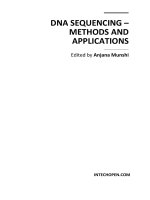BIOMETRIC SYSTEMS, DESIGN AND APPLICATIONS Edited by Zahid Riaz. pot
Bạn đang xem bản rút gọn của tài liệu. Xem và tải ngay bản đầy đủ của tài liệu tại đây (9.6 MB, 274 trang )
BIOMETRIC SYSTEMS,
DESIGN AND
APPLICATIONS
Edited by Zahid Riaz
Biometric Systems, Design and Applications
Edited by Zahid Riaz
Published by InTech
Janeza Trdine 9, 51000 Rijeka, Croatia
Copyright © 2011 InTech
All chapters are Open Access articles distributed under the Creative Commons
Non Commercial Share Alike Attribution 3.0 license, which permits to copy,
distribute, transmit, and adapt the work in any medium, so long as the original
work is properly cited. After this work has been published by InTech, authors
have the right to republish it, in whole or part, in any publication of which they
are the author, and to make other personal use of the work. Any republication,
referencing or personal use of the work must explicitly identify the original source.
Statements and opinions expressed in the chapters are these of the individual contributors
and not necessarily those of the editors or publisher. No responsibility is accepted
for the accuracy of information contained in the published articles. The publisher
assumes no responsibility for any damage or injury to persons or property arising out
of the use of any materials, instructions, methods or ideas contained in the book.
Publishing Process Manager Mirna Cvijic
Technical Editor Teodora Smiljanic
Cover Designer Jan Hyrat
Image Copyright lavitrei, 2011. Used under license from Shutterstock.com
First published September, 2011
Printed in Croatia
A free online edition of this book is available at www.intechopen.com
Additional hard copies can be obtained from
Biometric Systems, Design and Applications, Edited by Zahid Riaz
p. cm.
ISBN 978-953-307-542-6
free online editions of InTech
Books and Journals can be found at
www.intechopen.com
Contents
Preface IX
Part 1 Fingerprints Verification and Identification 1
Chapter 1 Reliability of Fingerprint
Biometry (Weibull Approach) 3
Robert Brumnik, Iztok Podbregar and Teodora Ivanuša
Chapter 2 Finger-Vein Recognition Based on Gabor Features 17
Jinfeng Yang, Yihua Shi and Renbiao Wu
Chapter 3 Efficient Fingerprint
Recognition Through Improvement
of Feature Level Clustering, Indexing and
Matching Using Discrete Cosine Transform 33
D. Indradevi
Part 2 Face Recognition 55
Chapter 4 Facial Identification Based on
Transform Domains for Images and Videos 57
Carlos M. Travieso-González,
Marcos del Pozo-Baños and Jesús B. Alonso
Chapter 5 Towards Unconstrained Face
Recognition Using 3D Face Model 77
Zahid Riaz, M. Saquib Sarfraz and Michael Beetz
Chapter 6 Digital Signature: A Novel
Adaptative Image Segmentation Approach 93
David Freire-Obregón, Modesto Castrillón-Santana and
Oscar Déniz-Suárez
Part 3 Iris Segmentation and Identification 109
VI Contents
Chapter 7 Solutions for Iris Segmentation 111
Milena Bueno Pereira Carneiro, Antônio Cláudio P. Veiga,
Edna Lúcia Flôres and Gilberto A. Carrijo
Chapter 8 Detecting Cholesterol Presence
with Iris Recognition Algorithm 129
Ridza Azri Ramlee, Khairul Azha and Ranjit Singh Sarban Singh
Chapter 9 Robust Feature Extraction and Iris
Recognition for Biometric Personal Identification 149
Rahib Hidayat Abiyev and Kemal Ihsan Kilic
Chapter 10 Iris Recognition System Using Support Vector Machines 169
Hasimah Ali and Momoh J. E. Salami
Part 4 Other Biometrics 183
Chapter 11 Verification of the Effectiveness of
Blended Learning in Teaching Performance
Skills for Simultaneous Singing and Piano Playing 185
Katsuko T. Nakahira, Yukiko Fukami and Miki Akahane
Chapter 12 Portable Biometric System of
High Sensitivity Absorption Detection 195
Der Chin Chen
Chapter 13 Texture Analysis for Off-Line Signature Verification 219
Jesus F. Vargas and Miguel E. Ferrer
Chapter 14 Design and Evaluation of a Pressure
Based Typing Biometric Authentication System 235
Momoh J. E. Salami, Wasil Eltahir and Hashimah Ali
Preface
Biometric authentication has been widely used for access control and security systems
over the past few years. It is the study of the physiological (biometric) and behavioral
(soft-biometric) traits of humans which are required to classify them. A general
biometric system consists of different modules including single or multi-sensor data
acquisition, enrollment, feature extraction and classification. A person can be
identified on the basis of different physiological traits like fingerprints, live scans,
faces, iris, hand geometry, gait, ear pattern and thermal signature etc. Behavioral or
soft-biometric attributes could be helpful in classifying different persons however they
have less discrimination power as compared to biometric attributes. For instance,
facial expression recognition, height, gender etc. The choice of a biometric feature can
be made on the basis of different factors like reliability, universality, uniqueness, non-
intrusiveness and its discrimination power depending upon its application. Besides
conventional applications of the biometrics in security systems, access and
documentation control, different emerging applications of these systems have been
discussed in this book. These applications include Human Robot Interaction (HRI),
behavior in online learning and medical applications like finding cholesterol level in
iris pattern. The purpose of this book is to provide the readers with life cycle of
different biometric authentication systems from their design and development to
qualification and final application. The major systems discussed in this book include
fingerprint identification, face recognition, iris segmentation and classification,
signature verification and other miscellaneous systems which describe management
policies of biometrics, reliability measures, pressure based typing and signature
verification, bio-chemical systems and behavioral characteristics.
Over the past few years, a major part of the revenue collected from the biometric
industry is obtained from fingerprint identification systems and Automatic
Fingerprint Identification Systems (AFIS) due to their reliability, collectability and
application in document classification (e.g. biometric passports and identity cards).
Section I provides details about the development of fingerprint identification and
verification system and a new approach called finger-vein recognition which studies
the vein patterns in the fingers. Finger-vein identification system has immunity to
counterfeit, active liveliness, user friendliness and permanence over the conventional
fingerprints identification systems. Fingerprints are easy to spoof however current
approaches like liveliness detection and finger-vein pattern identification can easily
X Preface
cope with such challenges. Moreover, reliability measure of fingerprint systems using
Weibull approach is described in detail.
Human faces are preferred over the other biometric systems due to their non-intrusive
nature and applications at different public places for biometric and soft-biometric
classification. Section II of the book describes detailed study on the segmentation,
recognition and modeling of the human faces. A stand-alone system for 3D human
face modeling from a single image has been developed in detail. This system is
applied to HRI applications. The model parameters from a single face image contain
identity, facial expressions, gender, age and ethnical information of the person and
therefore can be applied to different public places for interactive applications.
Moreover face identification in images and videos is studied using transform domains
which include subspace learning methods like PCA, ICA and LDA and transforms like
wavelet and cosine transforms. The features extracted from these methods are
comparatively studied by using different standard classifiers. A novel approach
towards face segmentation in cluttered backgrounds has also been described which
provides an image descriptor based on self-similarities which captures the general
structure of an image.
Current iris patterns recognition systems are reliable but collectability is the major
challenge for them. A thorough study along with design and development of iris
recognition systems has been provided in section III of this book. Image segmentation,
normalization, feature extraction and classification stages are studied in detail. Besides
conventional iris recognition systems, this section provides medical application to find
presence of cholesterol level in iris pattern.
Finally, the last section of the book provides different biometric and soft-biometric
systems. This provides management policies of the biometric systems, signature
verification, pressure based system which uses signature and keyboard typing,
behavior analysis of simultaneous singing and piano playing application for students
of different categories and design of a portable biometric system that can measure the
amount of absorption of the visible collimated beam that passes by the sample to
know the absorbance of the sample.
In summary, this book provides the students and the researchers with different
approaches to develop biometric authentication systems and at the same time
provides state-of-the-art approaches in their design and development. The approaches
have been thoroughly tested on standard databases and in real world applications.
Zahid Riaz
Research Fellow
Faculty of Informatics
Technical University of Munich
Garching, Germany
Part 1
Fingerprints Verification and Identification
1
Reliability of Fingerprint Biometry
(Weibull Approach)
Robert Brumnik
1
, Iztok Podbregar
2
and Teodora Ivanuša
2
1
Metra inženiring Ltd.
2
University of Maribor,
Faculty of Criminal Justice and Security
Slovenia
1. Introduction
Biometrics refers to the identification of a person on the basis of their physical and
behavioural characteristics. Today we know a lot of biometric systems which are based on
the identification of these, for everyone's unique identity. Some biometric systems include
the characteristics of: fingerprints, hand geometry, voice, iris, etc., and can be used for
identification. Most biometric systems are based on the collection and comparison of
biometric characteristics which can provide identification. This study begins with a
historical review of biometric and radio frequency identification (RFID) methods and
research areas. The study continues in the direction of biometric methods based on
fingerprints. The survey parameters of reliability, which may affect the results of the
biometric system in use, prove the hypothesis. A summary of the results obtained the
measured parameters of reliability and the efficiency of the biometric system we discussed.
Each biometric system includes the following three processes: registration, preparation of a
sample, and readings of the sample. Finally the system provides a comparison of the
measured sample with digitized samples stored in the database. Also in this chapter we
show the optimization of a biometric system with neural networks resulting in multi-
biometric or multimodal biometric systems. This procedure combines two or more biometric
methods in the form of a more efficient and more secure biometric system.
During our research we carried out a »Weibull« mathematical model for determining the
effectiveness of the fingerprint identification system. By means of ongoing research and
development projects in this area, this study is aimed at confirming its effectiveness
empirically. Efficiency and reliability are important factors in the reading and operation of
biometric systems. The research focuses on the measurement of activity in the process of the
fingerprint biometric system, and explains what is meant by the result achieved.
The research we refer to reviews relevant standards, which are necessary to determine the
policy of biometric measures and security mechanisms, and to successfully implement a
quality identification system.
The hypothesis, we have assumed in the thesis to the survey has been fully confirmed.
Biometric methods based on research parameters are both more reliable and effective than
RFID identification systems while enabling a greater flow of people.
Biometric Systems, Design and Applications
4
2. Theoretical overview
Personal identification is a means of associating a particular individual with an identity. The
term “biometrics” derives from Bio,(meaning “life” and metric being a “measurement”.
Variations of biometrics have long been in use in past history. Cave paintings were one of
the earliest samples of a biometric form. A signature could presumably be decifered from
the outline of a human hand in some of the paintings. In ancient China, thumb prints were
found on clay seals. In the 14th century in China, biometrics was used to identify children to
merchants (Daniel, 2006). The merchants would take ink and make an impression of the
child’s hand and footprint in order to distinguish between them. French police developed
the first anthropometric system in 1883 to identify criminals by measuring the head and
body widths and lengths. Fingerprints were used for business transactions in ancient
Babylon, on clay tablets (Barnes, 2011).
Throughout history many other forms of biometrics, which include the fingerprint
technique, were utilized to identify criminals and these are still in use today. The fingerprint
method has been successfully used for many years in law enforcement and is now a very
accurate and reliable method to determine an individual’s identity in many security access
systems.
The production logistics must ensure an effective flow of material, tools and services during
the whole production process and between companies. Solutions for the traceability of
products and people (identification and authentication) are very important parts of the
production process. The entire production efficacy and final product quality depends on the
organization and efficiency of the logistics process. The capability of a company to develop,
exploit and retain its competitive position is the key to increasing company value (Polajnar,
2005). Globalization dictates to industrial management the need for an effective and lean
manufacturing process, downsizing and outsourcing where appropriate. The requirements
of modern times are the development and use of wireless technologies such as the mobile
phone. The intent is to develop remote maintenance, remote servicing and remote
diagnostics (Polajnar, 2003). With the increasing use of new identification technologies, it is
necessary to explore their reliability and efficacy in the logistics process. With the evolution
of microelectronics, new identification systems have been achieving rapid development
during the last ten years thus enabling practical application in the branch of automation of
logistics and production. It is necessary to research and justify every economic investment in
these applications.
Biometrics is not really a new technology. With the evolution of computer science the
consecutive manner in which we can now use these unique features with the aid of
computers contemporaneousness. In the future, modern computers will aid biometric
technology playing a critical role in our society to assist questions related to the identity of
individuals in a global world.
“Who is this person?”, “Is this the person he/she claims to be?”, “Should this individual be
given access to our system or building?”, etc. These are examples of the every day questions
asked by many organizations in the fields of telecommunication, financial services, health
care, electronic commerce, governments and others all over the world.
The requirements and needs of quantity data and information processing are growing by
the day. Also, people’s global mobility is becoming an everyday matter as is the necessity to
ensure modern and discreet identification systems from different real and virtual access
points on a global basis.
Reliability of Fingerprint Biometry (Weibull Approach)
5
3. Quality parameters of biometrics technologies (ER, FRR, FAR, SL, EC)
In order to adopt biometric technologies such as fingerprint, iris, face, hand geometry and
voice etc., we will evaluate some factors including the ease of use, error rate and cost. When
we evaluate the score for each of the biometric technologies, we find that there is a range
between the upper and lower scores for each item evaluated. Therefore we have to
recognize that there is no perfect biometric technology.
For example, if a biometric system uses fingerprint technology, we will determine several
factors as follows:
a. What is the error rate (ER), as we use the False Acceptance Rate (FAR) or False Rejection
Rate (FRR) that the system will allow?
b. False Acceptance Rate (FAR) is the probability that a biometrics verification device will
fail to reject an impostor.
c. False Rejection Rate (FRR) is the probability that a biometrics verification device will
fail to recognize the identity, or verify the claimed identity, of an enrolee.
d. What is the security level (SL) to protect privacy and fraud that the system will require?
e. Which environmental conditions (EC) for sensing fingerprints will be considered as dry
or wet and dusty on the glass of a fingerprint scanner?
In the last ten years, new identification systems have been achieving extremely rapid
development. The evolution of microelectronics has enabled practical application in the
branch of automation of logistics and production. It is necessary to research and justify
every economic investment in these applications. In this work the most important
quantitative characteristics of reliability are explained. The authors also show the
methodology for defining the reliability and efficacy of biometric identification systems in
the process of identification and provide experimental research of personal identification
systems
1
based upon reliability and efficacy parameters. Furthermore, a real identification
system was upgraded based on automation and informatization.
In this article based on Biometric Identification Systems, we:
show the availability and efficacy of analyses in the identification processes,
extend reliability estimations of biometric identification systems based on significant
reliability characteristics,
provide a contribution to science by researching the biometric automated identification
process to ensure optimal procedures.
A review of scientific databases shows that the area of assessing the reliability of identification
systems in the process of production and logistics is not well explored. In modern production
and logistics processes (automobile industry, aerospace industry, pharmacy, forensics, etc.) it
is necessary to have fast and reliable control over the flow of people.
4. Defining the problem and research parameters
The availability of a production-logistic process is the probability that the system is
functioning well at a given moment or is capable of functioning when used during certain
1
Personal Identification Systems; Recent events have heightened interest in implementing more secure
personal identification (ID) systems to improve confidence in verifying the identity of individuals
seeking access to physical or virtual locations in the logistic process. A secure personal ID system must
be designed to address government and business policy issues and individual privacy concerns. The ID
system must be secure, provide fast and effective verification of an individual’s identity, and protect the
privacy of the individual’s identity information.
Biometric Systems, Design and Applications
6
circumstances. Reliability, by definition, is probability (capability) of the system to perform
under the stated conditions defined by function and time (Hudoklin & Rozman, 2004). It is
one of the most important characteristics of efficacy of identification systems and has an
impact on safety and efficiency of the system. Military standard MIL HDBK 217 is also used
to estimate the inherent reliability of electronic equipment and systems based on component
failure data. It consists of two basic prediction methods: Parts-Count Analysis and Part-
Stress Prediction. Increasing the system’s reliability means less improper use, greater safety,
fewer repair procedures and shorter identification times, consequently causing higher
system availability. Implementing higher reliability in early development phases and its
assurance during the use of the identification system, requires the knowledge of methods
and techniques of reliability theory and their interactions.
Many different characteristics are used to measure the reliability of identification systems
and their components. Some of them are connected to time functions others represent
average time functions. Which of these characteristic are relevant in specified cases depends
on the set goals, selected method of analysis, and the availability of data.
Characteristics of reliability are based on mean time intervals to the occurrence of failure.
Time to failure is a random magnitude and we will mark it with the symbol “t
i
”. In this
article we give definitions and statistical estimations of basic reliability characteristics.
Reliability characteristics used in this research are:
MTTF - mean time to failure
MTBF - mean time between failures
MTTR - mean time to repair
F(t) - unreliability function
λ(t)- failure rate
β - shape parameter
a. β<1 temporary failure frequency λ(t) decreases (early period, system
implementation)
b. β=1 temporary failure frequency λ(t) is constant (normal system operation)
c. β >1 temporary failure frequency λ(t) increases (exploitation, ageing)
The shape parameter (β) changes the configuration of the temporal distribution of
operational failures.
5. Quantitative reliability characteristics
The theory of reliability was obtained by the authors Hudoklin and Rozman (2004):
Unreliability function F(t) is defined by the equation:
() ( )Ft PX t
(1)
F(t) is therefore the probability of a system to become non-functional in the interval between
0 and t.
If we observe a number of systems, or system components, we can calculate the statistical
estimation for the unreliability function by the equation:
0
0
()
()
NNt
Ft
N
(2)
N(t) - number of working/functional samples in the interval (0,t)
Reliability of Fingerprint Biometry (Weibull Approach)
7
N0 - number of samples at the start of observation at t=0
Reliability function R(t) is complementary to the unreliability function. We can define it
using the equation:
() 1 () ( )Rt Ft PX t
(3)
R(t) is the probability that a system or component will become non-functional after a time
period t. We can define a statistical estimation of the reliability function using the equation:
0
()
()
Nt
Rt
N
(4)
The product of the time to failure function and dt is the probability of the system or its
component to become non-functional in the interval (t, t+Δt). We can calculate the function
F(t) by differentiation of the unreliability function by time:
()
()
dF t
Ft
dt
(5)
The statistical estimation for f(t) can be calculated with the equation:
0
() ( )
()
Nt Nt t
ft
Nt
(6)
Where Δt is interval (t, t+Δt).
Product of Failure rate λ(t) and dt is the conditional probability of a system/part of a system
to become non-functional in the interval (t, t+Δt).Momentary frequency of failure rate can be
written as:
()
()
()
f
t
t
Rt
(7)
The statistical estimation for λ(t) is defined with the equation:
() ( )
ˆ
()
()
Nt Nt t
t
Nt t
(8)
The mean time to failure (MTTF) of the system reliability is a characteristic and not a
function of time, but the average value of the probability density function for the times to
failure:
00
() ()
M
TTF t
f
tdt Rtdt
(9)
An estimate point for the mean time to failure (MTTF) is calculated for n times to failure
with the estimator:
1
1
ˆ
n
i
i
M
TTF t
n
(10)
Biometric Systems, Design and Applications
8
During normal operation, the MTTF is equal to:
1
MTTF
(11)
For many systems, or system parts, the function λ(t) has a characteristic “bathtub”
configuration (Figure 1.). The life cycle of systems can be divided into three periods: an early
damaging period, a normal working period and an ageing or exploitation period. In the first
period λ(t) decreases, in the second period λ(t) is constant, and in the third period λ(t) rises.
Fig. 1. ”Bathtub“ curve (FIDES, 2006).
5.1 Reliability of biometric identification systems
Definitions used in reliability calculation of biometric identification systems and
terminology:
FAR
2
is defined as the percentage of identification instances in which false acceptance
occurs,
FRR
3
is defined as the percentage of identification instances in which false rejection
occurs,
Mean time to failure (MTTF), mean time between failures (MTBF) and mean time to
repair (MTTR),
classification of failures,
failures data bases.
In biometric methods, in contrast to the classic methods of identification, probability needs to
be considered. All sensors are subject to noise and errors. The largest problem is the
development and implementation of a safe crypto-algorithm. All limitations are summarized
in the two terms: FRR and FAR. If a system is highly sensitive, the FAR value is low, but FRR
is higher. In a system of low sensitivity the situation is reversed. Such a system is accepted by
almost everyone (FAR>FRR). It is therefore necessary to make a compromise in the sensitivity
of a system. It can also be regulated so that the FAR and FRR values are equal, the so-called
EER (Equal Error Rate). Lower EER means a more accurate system. In an application where
the speed of identification is more important than safety (e.g. hotel rooms), the high FAR value
2
FAR (False Aceptance Rate); This can be expressed as a probability. For example, if FAR is 0.1 percent, it
means that on average, one out of every 1000 impostors attempting to breach the system will be successful.
3
FRR (False Recetion Rate); For example, if FRR is 0.05 percent, it means that on average, one out of
every 2000 authorized persons attempting to access the system will not be recognized by that system.
Reliability of Fingerprint Biometry (Weibull Approach)
9
can be allowed (Hicklin et al., 2005). Graphic presentation of both errors depending on the size
of the error threshold of biometric system can be seen in Figure 2.
Fig. 2. Calculating EER from FAR – FRR intersection.
5.2 Usability and reliability characteristics of a biometric system reader
To fully understand user-centered design, it is essential to understand the features inherent
in a usable system. Usability helps to ensure that systems and products are easy to learn,
effective to use and enjoyable from the user’s perspective. This is defined as: “The extent to
which a product can be used by specified users to achieve specified goals with effectiveness,
efficiency, and satisfaction in a specified context of use.” (ISO 13407:1999). Additional
attributes of usability that may also be considered include:
effective to use (effectiveness),
efficient to use (efficiency),
enjoyable to use (satisfaction),
easy to learn (learnability) and
easy to remember (memorability).
The table on the next page lists each of these usability goals and provides a short description
of each, along with a few questions for biometric system designers to consider. Usability
testing not only provides insights into users’ behaviour, but it also allows project teams to
quantifiably measure the success of a system, including capturing metrics such as error
rates, successful performance on tasks, time to complete a task, etc. (NIST, 2008). For
quantitative testing, many teams use the Common Industry Format (CIF) (ISO/IEC
25062:2006) to document the performance of the system. The CIF provides a standard way
for organizations to present and report quantitative data gathered in a usability test, so that
it can later be compared to the results gathered in subsequent tests.
A review of the literature and standards for design and anthropometric measurements
provided guidance on proper angles for fingers or palm placement. Standards focus on line
of sight and reach envelopes including sloping control panels for cockpits or nuclear power
stations (NISTIR 7504).
To determine the reliability characteristics, we used the Weibull model, which is useful in
cases where λ(t) cannot be illustrated by the constant function. For the resulting
measurements we will take advantage of Weibull analysis, which provides a simple
Biometric Systems, Design and Applications
10
graphical method. The analysis will be provided (with a reasonable error analysis) to obtain
good estimates of parameters, despite the small sample size (in our case, thirty pieces of
biometric modules). These solutions enable us to identify early signs of potential problems,
so we can prevent more serious systemic failures and predict the maintenance cycle
(increasing the availability of the system). The study was of a relatively small sample size
also enabling cost-effective test curves. Testing is complete when the observed system fails
(sudden failure) in each of the three groups (the first module of each series) biometric reader
components and proceeds with the Weibull analysis.
Reliability of a biometric system depends on three factors (Chernomordik, 2002):
uniqueness and repeatability, which means that the characteristic used should provide
for different readings for different people, and the readings obtained for the same
person at different times and under different conditions should be similar,
reliability of the matching algorithm and
quality of the reading device.
Failures, which we have taken into account in determining the characteristics of MTTF and
MTTR of a biometric system (Table 1):
failure of the software (the inability to read the sample),
failure of hardware (biometric reader, PCBs) and
errors due to sensor reading settings: FAR, FRR.
Ser. No.
Time to first failure
(days)
Time to second
failure (days)
Time to third
failure (days)
Average value
(days)
36365 53 89 88
88,8
36359 60 106 73
36366 87 106 88
36364 86 161 88
36368 102 130 13
36369 99 102 98
36360 56 150 93
36345 57 90 126
36381 81 52 117
36384 90 65 105
Ser. No.
Time to first repair
(days)
Time to second
repair (days)
Time to third
repair (days)
Average value
(days)
36365 1 1 1
1,2
36359 0 1 0
36366 1 3 2
36364 1 0 1
36368 1 3 1
36369 2 1 1
36360 2 1 1
36345 3 1 1
36381 2 1 1
36384 2 0 1
Reliability of Fingerprint Biometry (Weibull Approach)
11
Ser. No.
Time to restart
(days)
Time to restart
(days)
Time to restart
(days)
Average value
(days)
36365 56 90 89
90,1
36359 60 105 73
36366 88 107 90
36364 85 161 89
36368 103 133 16
36369 101 103 99
36360 58 151 96
36345 60 91 127
36381 83 53 118
36384 92 65 106
Table 1. Data for the MTTF, MTTR estimates determine for biometric system.
TIME TO FIRST FAILURE (days)
i
1 2 3 4 5 6 7 8 9 10
t
i
(days) 53 56 57 60 81 86 87 90 99 102
F
i
7 16 26 36 45 55 64 74 84 93
TIME TO SECOND FAILURE (days)
i
1 2 3 4 5 6 7 8 9 10
t
i
(days) 52 65 89 90 102 106 106 130 150 161
F
i
7 16 26 36 45 55 64 74 84 93
TIME TO THIRD FAILURE (days)
i
1 2 3 4 5 6 7 8 9 10
t
i
(days) 13 73 88 88 88 93 98 105 117 126
F
i
7 16 26 36 45 55 64 74 84 93
Table 2. The times to failure and the associated estimates points for F(t) of the biometric
system.
TIME TO FIRST ACTIVE REPAIR (days)
i
1 2 3 4 5 6 7 8 9 10
t
i
1 0 1 1 1 2 2 3 2 2
TIME TO SECOND ACTIVE REPAIR (days)
i
1 2 3 4 5 6 7 8 9 10
t
i
1 1 3 0 3 1 1 1 1 0
TIME TO THIRD ACTIVE REPAIR (days)
i
1 2 3 4 5 6 7 8 9 10
t
i
1 0 2 1 1 1 1 1 1 1
Table 3. The times of active repairs for the biometric module.
Biometric Systems, Design and Applications
12
Assuming that the times to failure in Tables 2 are exponentially distributed couples (t
i
, F
i
).
We join them together and rank them in Table 4 and estimate parameters β and η for a
biometric system with the software Weibull++7.
Time to first failure is β = 4.6 and η = 72, while they are behind the times to failure of
another parameter β = 3.23 and η = 117.2. For the third time to failure, the values of
parameters β = 2 and η = 101. Table 4 shows the ranking values of times to failure of
biometric systems (ti; i=1,2,3) and times to failure of the biometric identification system and
the corresponding estimation point estimates of F(t).
biometric module
i
t
i
(da
y
s)
F
i
1 13 2,3
2 52 5,6
3 53 8,9
4 56 12,2
5 57 15,5
6 60 18,8
7 65 22,0
8 73 25,3
9 81 28,6
10 86 31,9
11 87 35,2
12 88 38,5
13 88 41,8
14 88 45,1
15 89 48,4
16 90 51,6
17 90 54,9
18 93 58,2
19 98 61,5
20 99 64,8
21 102 68,1
22 102 71,4
23 105 74,7
24 106 78,0
25 106 81,3
26 117 84,5
27 126 87,8
28 130 91,1
29 150 94,4
30 161 97,7
Table 4. Ranking times to failure for the biometric system and estimation point estimates of
F(t).
Reliability of Fingerprint Biometry (Weibull Approach)
13
For the biometrics module we provide an estimated point of the average time of repairs:
1
11
ˆ
15 12 10 1,2
30
r
i
i
M
TTR t days
r
Estimates point for the availability of a biometric module for the period of observation is:
88,8
ˆ
0,987
88,8 1,2
MTTF
A
MTTF MTTR
With the Weibull++7 analysing tool we modeled probability density for time to failure of a
biometric system with a distribution law and with the Weibull parameters β and η (Figure
3). At 100% probability, a failure of a biometric system, appears at β = 2.8 and η = 101.7.
Fig. 3. Weibull model of failure appear for biometric system.
5.3 MTTF model calculation of system with two equivalent parts in parallel
configuration
In practice, a request is made for the smooth functioning of the identification system, despite
the likelihood of failure of a biometric card reader (airports, local government units, police
stations, etc.). To increase the reliability of the biometric system and ensure the continuous
operation despite the failure, we can associate two equivalent unit biometric module
dynamic readings in the event of termination of the first reader to function by another









